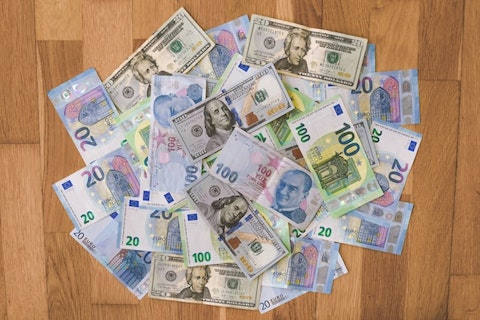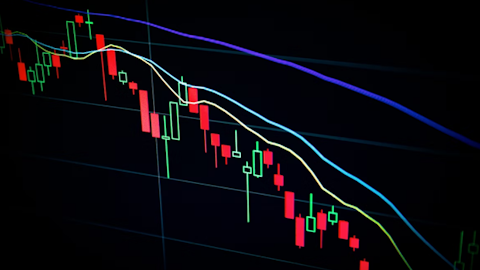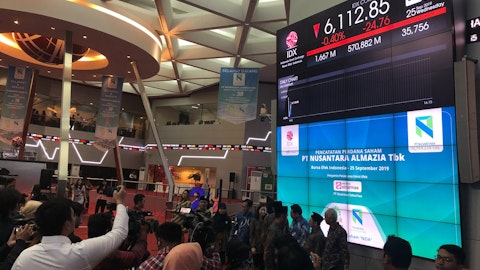Main Street Capital Corporation (NYSE:MAIN) Q4 2022 Earnings Call Transcript February 24, 2023
Operator: Greetings, and welcome to the Main Street Capital Corporation Fourth Quarter Earnings Conference Call. At this time, all participants are in a listen-only mode. A brief question-and-answer session will follow the formal presentation. As a reminder, this conference is being recorded. It is now my pleasure to introduce your host, Zach Vaughan with Dennard Lascar, Investor Relations. Thank you, sir. You may begin.
Zach Vaughan: Thank you, operator, and good morning, everyone. Thank you for joining us for Main Street Capital Corporation’s fourth quarter 2022 earnings conference call. Joining me today with prepared comments are Dwayne Hyzak, Chief Executive Officer; David Magdol, President and Chief Investment Officer; and Jesse Morris, Chief Financial Officer and Chief Operating Officer. Also participating for the Q&A portion of the call is Nick Meserve, Managing Director and Head of the Private Credit Investment Group. Main Street issued a press release yesterday afternoon that details the company’s fourth quarter and full year financial and operating results. This document is available on the Investor Relations section of the company’s website at mainstcapital.com.
A replay of today’s call will be available beginning an hour after the completion of the call and will remain available until March 3. Information on how to access the replay was included in yesterday’s release. We also advise you that this conference call is being broadcast live through the Internet and can be accessed on the company’s home page. Please note that information reported on this call speaks only as of today, February 24, 2023, and therefore, you are advised that time-sensitive information may no longer be accurate at the time of any replay listening or transcript reading. Today’s call will contain forward-looking statements. Many of these forward-looking statements can be identified by the use of words such as anticipates, believes, expects, intends, will, should, may or similar expressions.
These statements are based on management’s estimates, assumptions and projections as of the date of this call, and there are no guarantees of future performance. Actual results may differ materially from the results expressed or implied in these statements as a result of risks, uncertainties and other factors, including, but not limited to, the factors set forth in the company’s filings with the Securities and Exchange Commission, which can be found on the company’s website or at sec.gov. Main Street assumes no obligation to update any of these statements unless required by law. During today’s call, management will discuss non-GAAP financial measures, including distributable net investment income. Please refer to yesterday’s press release for a reconciliation of these measures to the most directly comparable GAAP financial measures.
Certain information discussed on this call, including information related to portfolio companies, was derived from third-party sources and has not been independently verified. And now I’ll turn the call over to Main Street’s CEO, Dwayne Hyzak.
Dwayne Hyzak: Thank you, Zach. Good morning, everyone, and thank you for joining us today. We appreciate your participation on this morning’s call. We hope that everyone is doing well. On today’s call, I’ll provide my usual updates regarding our performance in the quarter, while also providing a few updates on our performance for the full year. I’ll also provide updates on our asset management activities, our recent declarations of another supplemental dividend payable in March and our regular monthly dividends for the second quarter of 2023, our expectations for dividends going forward, our recent investment activities and current investment pipeline and several other noteworthy updates. Following my comments, David and Jesse will provide additional comments regarding our investment strategy, investment portfolio, financial results, capital structure and leverage, and our expectations for the first quarter of 2023, after which we will be happy to take your questions.
We’re very pleased with our fourth quarter results, which closed a record year for Main Street across several key performance indicators, with significant positive momentum for 2023. Our results include new quarterly records for Net Investment Income or NII per share and Distributable Net Investment Income, or DNII, per share, significantly exceeding our records achieved in the third quarter and representing the sixth consecutive quarter in which we set or matched our NII per share record. This consistent strong performance demonstrates the continued and sustainable strength of our overall platform, the benefits of our differentiated and diversified investment strategies and the underlying quality of our portfolio companies. We’re also pleased that the positive results included strong contributions from both our lower middle market and private loan investment strategies and our asset management business, providing us confidence about the recurring nature of these positive results in the future.
As a result of our strong performance, our quarterly DNII per share exceeded $1 per share for the first time, and we generated an annualized net income return on equity of over 20%. We’re also pleased with the strong results for the full year, which also included record NII per share and DNII per share and allowed us to end the year at a record net asset value per share. After these record-breaking results, and some meaningful capital markets activities, we entered the New Year with a strong liquidity position and a conservative leverage profile. We remain very encouraged by the continued favorable performance of our diversified lower middle market and private loan investment strategies and remain confident that these strategies, together with the benefits of our asset management business and our cost-efficient operating structure will allow us to continue to deliver superior results for our shareholders over the long-term future.
These positive results and our favorable outlook for the first quarter resulted in our recommendation to our Board of Directors for our most recent dividend announcements, which I will discuss in more detail later. Our net asset value per share increased in the quarter, due to the impact of the fair value increases in several components of our investment portfolio and the positive impact of our equity issuances in the quarter. Our lower middle market portfolio companies continued their strong performance overall, which resulted in another quarter of meaningful fair value appreciation in the equity investments in this portfolio. And we are excited about the new and follow-on investments we made in our lower middle market portfolio companies during the quarter.
We expect that these follow-on investments will drive additional fair value appreciation in these portfolio companies in future quarters. We also benefited from meaningful fair value appreciation in our private loan portfolio, and in the value of our wholly owned registered investment adviser, through a combination of portfolio company-specific and broader market-based drivers. We also continue to have favorable investment activities in the fourth quarter. Our lower middle market investments of $152 million in the quarter resulted in a net increase in lower middle market investments, after repayments of $127 million. This capped off another strong year of activity with total lower middle market investments of $373 million for the year, resulting in a net increase of $264 million.
Our private loan investment activities in the quarter included new investments of $86 million, which after aggregate repayments resulted in a net decrease in our private loan investments of $26 million. For the year, we completed $713 million of new investments, resulting in a net increase in our private loan portfolio of $335 million. Given our favorable liquidity position, after our recent capital market activities, which Jesse will address in his comments, which we achieved despite a very challenging capital markets environment, we are very well positioned to continue the growth of our investment portfolio over the next few quarters. We’ve also continued to produce positive results in our asset management business. The funds we advised through our external investment manager, including MSC Income Fund, a non-traded BDC and MS Private Loan Fund I, a private credit fund, continued to experience favorable performance in the fourth quarter.
This positive performance resulted in significant incentive fee income for our asset management business. And as a result, we received significantly higher dividends from our asset management business. We remain excited about our plans for these funds, as we execute on our investment strategies and other strategic initiatives, and we are optimistic about the future performance of the funds and the attractive returns we are providing to the investors of each fund. We are also optimistic about our strategy for growing our asset management business within our internally managed structure and are actively working to increase the contributions from this unique benefit to our Main Street stakeholders and we look forward to sharing additional details as we execute our plans for this business in 2023 and work to create additional value for the next few years.
Based upon our results for the fourth quarter, combined with our favorable outlook in each segment of our business and the benefits of our efficient operating structure, earlier this week, our Board declared a supplemental dividend of $0.175 per share payable in March, representing our largest and sixth consecutive quarterly supplemental dividend. Our Board also declared regular monthly dividends for the second quarter of 2023 at $0.225 per share payable in each of April, May and June, representing a 4.7% increase from the second quarter of 2022. The increased supplemental dividend for March is a result of our strong performance in the fourth quarter, which resulted in DNII per share that was $0.37 or 56% greater than our monthly dividends paid during the quarter.
The March 2023 supplemental dividend will result in total supplemental dividends paid during the trailing 12-month period of $0.45 per share, representing an additional 17% paid to our shareholders in excess of our regular monthly dividends. Including these supplemental dividends, our DNII per share for the fourth quarter exceeded our total dividends paid by $0.20 per share. We are pleased to be able to deliver the significant additional value to our shareholders, while also maintaining a significant portion of our excess earnings to support our capital structure and investment portfolio against risks from the current economic uncertainties that maybe realized in 2023 and to further enhance the growth of our NAV per share. As we’ve previously mentioned, we currently expect to recommend that our Board declare future supplemental dividends to the extent DNII significantly exceeds regular monthly dividends paid in future quarters, and we maintain a stable to positive net asset value.
Based upon our expectations for continued favorable performance in the first quarter, we currently anticipate proposing an additional supplemental dividend payable in June 2023. Now turning to our current investment pipeline. As of today and after our robust activity for the fourth quarter, I would characterize our lower middle market investment pipeline as below average. While the near-term pipeline is currently below average, we remain highly confident in our ability to generate significant new lower middle market investment opportunities in 2023. We also continue to be very pleased with the performance of our private credit team and the significant growth they have provided for our private loan portfolio and our asset management business.
And as of today, I’d characterize our private loan investment pipeline as average. With that, I will turn the call over to David.
David Magdol: Thanks, Dwayne, and good morning, everyone. Year-end provides a good opportunity to look back at our history and highlight the benefits of our unique and diversified investment strategy and discuss how this has enabled us to deliver attractive returns to our shareholders over an extended period of time. We believe looking back at our history also supports our intent to continue to execute our unique and highly differentiated strategy in the future. Since our IPO in 2007, we have increased our monthly dividends per share by 105%, and we have declared cumulative total dividends to our shareholders of $36.65 per share or over 2.4 times our IPO price of $15 per share. Our total return to shareholders since our IPO calculated using our stock price as of yesterday’s close and assuming reinvestment of all dividends received since our IPO was 8.6 times money invested.

Photo by Ibrahim Boran on Unsplash
This compares very favorably to 2.5 times money invested for the S&P 500 over the same period of time and is significantly higher when compared to our BDC peers. As we’ve previously discussed, we believe that the primary drivers of our long-term success have and will continue to be our focus on making both debt and equity investments in the underserved lower middle market. Growing our private credit activities for the benefit of our balance sheet and for the clients of our Asset Management business, which clearly benefits our shareholders and our industry-leading cost structure, which provides for a strong alignment of interest between our management team and shareholders through our team’s meaningful stock ownership and incentive compensation plan, which is tied to our ability to achieve superior financial results for our shareholders.
Most notably and uniquely, our lower middle market strategy provides attractive leverage points and yields on our first lien debt investments, while also creating a true partnership with the management teams of our portfolio companies through our flexible equity ownership structures. This approach provides significant downside protection through our first lien debt investments, while still providing the benefits of alignment and significant upside potential with our equity investments made alongside our portfolio company management team partners. Our long-term historical track record of investing in the lower middle market, coupled with our view that this market continues to be underserved gives us confidence that we will be able to continue to find attractive new investment opportunities in this important cornerstone of our business in the future.
In 2022, Main Street invested $373 million in our lower middle market strategy. $137 million of this capital is deployed in five new lower middle market platform companies with the remaining $236 million represented follow-on investments in existing fees and lower middle market companies. Consistent with our comments in prior quarters, these follow-on investments were made to support the growth strategies in some of our highest performing portfolio companies, which makes this aspect of our lower middle market investment activity very exciting for us. Consistent with our guidance in prior quarters, 2022 represents the strongest year of add-on investments in our lower middle market companies in Main tree’s history. Our follow-on investment investments are typically used to support multiple objectives, including acquisitions, diversification opportunities, product or geographic expansion and recapitalization transactions.
These follow-on investments support proven management teams that intrinsically plus less investment risk when compared to providing capital to new portfolio companies. Since we are significant equity owners in our lower middle market companies, we benefit from participating alongside the proven managers in these businesses as they strive to achieve meaningful equity value creation. As we’ve stated in the past, our lower middle market portfolio companies perform over time to naturally deleverage with free cash flow generated from operations. This also allows us, along with our lower middle market portfolio management team partners to benefit from the distributions received from this cash flow. Given the strength and quality of our lower middle market portfolio, we expect dividend income to continue to be a primary contributor to our results in 2023.
Additionally, this deleveraging, coupled with the attractive underlying operating results at our floor middle market portfolio companies allowed us to achieve $75 million in fair value appreciation in realized activities. This benefit in our lower middle market equity investments is unique among our BDC peers with value appreciation along with realized gains serving to offset losses we will naturally incur in our investing activities. Our unrealized equity appreciation also provides potential upside to Main Street’s net asset value that other BDCs simply do not have. The last important area I’d like to cover regarding our 2022 accomplishments are the impressive contributions that our private credit team delivered during the year. Our private credit team continued to execute on our strategy to dedicate significant resources towards growing the private loan segment of our business, while deemphasizing our middle market portfolio, which, as a reminder, typically includes investments in larger syndicated loans.
Our purposeful and intentional strategic shift over the last five years to grow our private loan portfolio is primarily driven by our belief that an attractive and growing direct lending environment exists, and that private loan investments provide an attractive risk-adjusted return profile for Main Street. During 2022, Main Street invested $713 million in our private loan strategy, which helped increase our private loan portfolio by 29% and purposely decreased our middle market portfolio by 17%. As a result, at year-end, our private loan portfolio has grown to represent 36% of our total investments at fair value and the middle market portfolio declined by 300 basis points to represent 8% of our total investments at fair value. As Dwayne discussed earlier, our private loan capabilities also support our key strategic intention to continue growing our asset management business.
Now turning to our current portfolio. As of December 31, we had investments in 194 portfolio companies spanning across more than 50 different industries. Our largest portfolio company represented 3.4% of our total investment income for the year and 3.2% of our total investment portfolio fair value at year-end. The majority of our portfolio investments represented less than 1% of our income and our assets. Our investment activity in the fourth quarter included total investments in our lower middle market portfolio of $152 million, which after aggregate repayments on debt investments and return of invested equity capital resulted in a net increase in our lower middle market portfolio of $127 million. During the quarter, we also made $86 million in private loan investments, which after aggregate repayments of debt investments and return of invested equity capital resulted in a net decrease in our private loan portfolio of $26 million.
Finally, during the quarter, we had a net decrease in our middle market portfolio of $19 million. At year-end, our lower middle market portfolio included investments in 78 companies representing over $2.1 billion of fair value, which is over 20% above our cost basis. We had investments in 85 companies in our private loan portfolio, representing $1.5 billion of fair value. In our middle market portfolio, we had investments in 31 companies representing $329 million at fair value. Total investment portfolio at fair value at year-end was 109% of the related cost basis. Additional details on our investment portfolio at year-end are included in the press release that we issued yesterday. With that, I will turn the call over to Jesse to cover our financial results, capital structure and liquidity position.
Jesse Morris: Thank you, David. To echo Dwayne’s and David’s comments, we are pleased with our operating results for the fourth quarter, which included a number of quarterly records and capped the year with Main Street achieving records for net investment income, distributable net investment income and net asset value, all on a per share basis. Our total investment income for the fourth quarter represented another consecutive quarterly record, increasing by $31.7 million or 38.6% over the same period in 2021 to a total of $113.9 million. The fourth quarter surpassed our most recent quarterly record for total investment income flat in the third quarter of 2022 by $15.5 million or 15.7%, including meaningful increases in interest, dividend and fee income, which demonstrates the continued strength and momentum of our investment and asset management strategies.
Interest income increased by $32.5 million from a year ago and $11.3 million over the third quarter. We estimate the continued benefit from increases in benchmark index rates, drove a little over half of the increase over the third quarter, with the remainder driven primarily by the continued growth in our portfolio debt investments. In addition, the combined favorable impact of certain elevated income items in the fourth quarter, including dividends and accelerated prepayment, repricing or other activities that are considered less consistent was approximately $2 million or $0.02 per share by the average of the prior four quarters and was comparable to such income amounts earned in the fourth quarter of 2021. Our operating expenses for the quarter increased by $7 million over the fourth quarter of 2021, largely driven by increases of $7.1 million in interest expense, $1.5 million in general and administrative expenses and $0.7 million in share-based compensation, partially offset by a decline of $1.5 million in cash compensation related expenses and an increase of $0.8 million in expenses allocated to the External Investment Manager.
The ratio of our total operating expenses, excluding interest expense, as a percentage of our average total assets was 1.4% for the year and continues to be amongst the lowest in our industry. Our external investment manager contributed $7 million to our net investment income for the fourth quarter, an increase of $2.1 million from the same period of the prior year primarily due to a $1.9 million increase in incentive fees earned. During the quarter, we recorded net fair value appreciation, including net realized losses and net unrealized appreciation on the investment portfolio of $36.2 million, including net fair value appreciation of $24.2 million in our lower middle market portfolio, $9.2 million of our private loan portfolio and $10.4 million in our external investment manager.
These were partially offset by a net fair value depreciation of $8.8 million in our middle market portfolio. Net asset value or NAV per share increased by $0.92 over the third quarter and by $1.57 or 6.2% when compared to a year ago, to a record NAV per share of $26.86 at year end. We ended the fourth quarter with 12 investments on non-accrual status, comprising approximately 0.6% of the total investment portfolio at fair value and approximately 3.7% at cost. While not material to our NAV expectations for the next quarter, we did resolve a large and very long-standing non-accrual in the first quarter of 2023, which will impact these non-accrual stats at March 31, 2023. We continue to believe that our conservative leverage, strong liquidity and continued access to capital or significant strengths that have us well positioned for the future.
Given our belief of the importance of liquidity and a conservative capital structure, as we indicated on our third quarter conference call, we continue to explore additional sources of debt financing. During the fourth quarter, we were active on the capital front, including the execution of a new SPV credit facility with commitments of $255 million, the execution of a $100 million unsecured private placement notes, the repayment of the $185 million due on our 2022 notes at maturity and a net $71 million raised from equity issuances under our at-the-market program. As a result of these actions, we ended the year with strong liquidity, including cash and availability under our credit facilities of $617 million. Taken together with an additional $110 million provided by additional capital activities in January 2023, including the issuance of $50 million additional unsecured private placement notes and the expansion of commitments under our corporate credit facility by $60 million, we believe this provides us with the liquidity necessary to continue to be opportunistic and pursue attractive investment opportunities in 2023 while continuing to maintain a conservative leverage profile and healthy liquidity in these uncertain periods.
Our regulatory debt-to-equity leverage calculated its total debt, excluding our SBIC debentures, divided by net asset value was 0.79, and our regulatory asset coverage ratio was 227%, both of which are improvements from the third quarter and are intentionally slightly below the conservative end of our target ranges of 0.8 to 0.9x and 210% to 225%, respectively. Coming back to our operating results. Our return on equity for the fourth quarter was 20.8% on an annualized basis and 12.6% for the year. C&I per share for the quarter was a record $1.03 per share exceeding the total regular monthly dividends per share paid to our shareholders in the fourth quarter by $0.37 per share or approximately 56%. The NII per share for the quarter eclipsed our prior record in the third quarter of 2022 by $0.15 per share or 11.7%, an increase by $0.25 or 32.1% over the same period last year.
Total dividends paid in 2022 were $2.945 per share, including $0.35 per share in supplemental dividends, an increase of 14.4% over total dividends paid during 2021. As Dwayne mentioned, given the strength of our operating results and the outlook for 2023, our Board approved a supplemental dividend of $0.175 per share payable in March 2023. With this supplemental dividend, total declared dividends for the first quarter of 2023 are $0.85 per share, representing an 11.8% increase over the total monthly and supplemental dividends paid in the fourth quarter of 2022 and a total annualized yield of approximately 8.5%. As we look forward, given the strength of our underlying portfolio, we expect another strong top line and earnings quarter in the first quarter 2023 with expected DNII per share of at least $0.98 per share and with the potential for upside driven by the level of dividend income and portfolio investment activities during the quarter.
With that, I will now turn the call back over to the operator, so we can take any questions.
See also 10 Dividend Stocks that George Soros Owns and 15 Highest Yielding Dividend Stocks You Can Buy.
Q&A Session
Follow Main Street Capital Corp (NYSE:MAIN)
Follow Main Street Capital Corp (NYSE:MAIN)
Operator: At this time, we will be conducting a question-and-answer session. Our first question comes from Robert Dodd with Raymond James. Please proceed with your question.
Robert Dodd: Hi. Good morning. Congratulations on another really good quarter.
Dwayne Hyzak: Thanks Robert.
Robert Dodd: On dividend income, if I can, I know it’s hard to not just predict. But in this quarter, if I take out the dividend from the asset manager out to I-45, it was still a really strong dividend quarter just from the portfolio companies. I mean, 2021 was crazy, but still really strong. Can you give us any color you’ve given us some color in the past about, how much the concentration of what portion of the portfolio that income comes from? Can you give us any updates on that, or even maybe, how much of that income comes from portfolio companies you’ve held for
Dwayne Hyzak: Yeah.
Robert Dodd: five years or more or any breakdown you can give us for kind of the types, age concentration of the portfolio of companies is coming from?
Dwayne Hyzak: Sure, Robert. Thanks for the question. We’re happy to give you those details. As you said, and you’ll be able to see this when you see the 10-K, the contributions on the dividend income side are pretty broad-based. If you take out MSC Income Fund, it would take another 12 companies, on the lower middle market side before you got to 50% of the remaining dividend income. So we think it’s a nice diversity, contributions from a broad base of companies. Once you get past that 12, there’s a very large number of other companies that are meaningful contributors. So as you heard us say in our comments, we feel good about how the lower middle market companies are performing. You see that in both the appreciation we recognized in the quarter, but you also see it to the question you raised here to the point, you raised here with the broad-based dividend income that we saw from the portfolio in the fourth quarter.
Robert Dodd: Got it. Got it. Thank you for that. I mean, and then, the other question is, the lower middle market pipeline, you said, it’s below average. I mean, you also gave a lot more. But can you give me what — why currently, is it below average? Do you think is it a function of the outlook on the economic environment or for it to get to back to average or above average, do we need more certainty in kind the economy because, obviously, sellers with business owners, right? It’s not sponsors we got on the middle market deal, right? So they may have different views on the economy. Any color on, what it takes to get a rebound in the pipeline on that side of the business?
Dwayne Hyzak: Sure, Robert. So that statement we provide each quarter is always highly judgmental. So you’ve heard
Robert Dodd: Yeah.
Dwayne Hyzak: us get for a long time. I’d say, it’s below average today, largely because, the third quarter and fourth quarter were both very, very active, very robust time periods. As I said in my comments, while it is below average today, it’s not a concern. I think we feel very confident, very good about the ability of our platform to consistently generate lower middle market opportunities over the long term. Just as we sit here at this point in time, it’s a little bit slower, but it’s not a big concern for us. I think, we expect to be active. That’s why we’ve prepared ourselves from a capital structure standpoint to continue to be active and continue to grow in that area. And we just need the market to reset a little bit and see the sellers’ expectations go back into being in line with where we need them to be from an execution standpoint. I’ll let David add any additional comments he has there.





